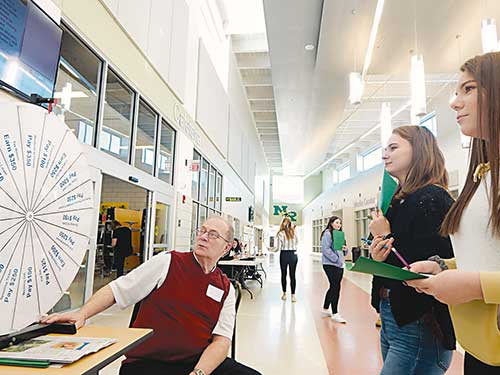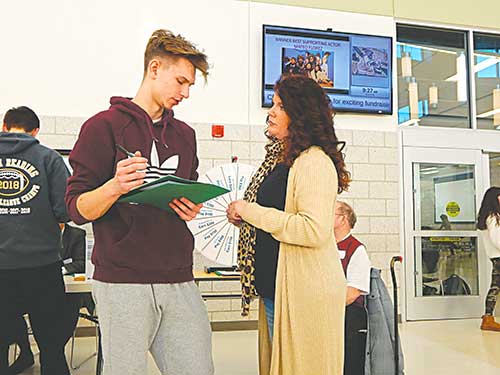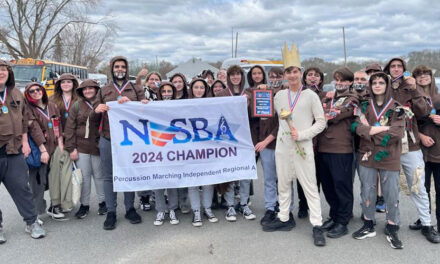Published March 28, 2019
By MICHAEL GEOFFRION SCANNELL
NORTH READING — This year’s North Reading High School junior class got an opportunity to experience real life at the third annual Reality Fair.
The idea is this: a couple of weeks before last Thursday’s event all juniors at the school were asked what career they would like to pursue at the end of their education. The responses were researched and a starting salary for each career was determined.
At the Reality Fair each student was given a checklist. They were also given their salary figure and asked to spend one month’s worth of their income on a variety of required and optional items. They had to acquire housing and food. The required items also included things like student loans, transportation and health insurance. Optional items included life insurance, internet and cable, recreation and leisure, and, if they chose, personal dental insurance. If they had any money left after making major life choices they could spend it on something like a vacation.

VOLUNTEER Ed Luckiewicz gives the Wheel of Life a spin for Katie O’Connell (center) and Brianna Grasso at the Reality Fair. The good news? Someone scored concert tickets. The bad news? Buying them reduces the monthly budget by $100. (Michael Geoffrion Scannell Photo)
The event was coordinated by North Reading’s new Youth Services Director, Jennifer Ford. “I’m thrilled with the success of my first Reality Fair as Director of Youth Services. It’s a fantastic concept and I’m excited to carry it on,” Ford said.
In addition to it being “a really cool experience” for the juniors, Ford believes the event is a testament to the power of collaboration. “The event wouldn’t happen without the time and commitment of over 40 individuals, including high school administration, food services and maintenance teams, NRPD, several different Rotary Clubs, and volunteers from a wide range of community businesses, boards and committees,” she said.
According to Ford, the students’ reactions ranged from excitement to apprehension to interest. Their evaluations of the Reality Fair indicated that nearly 83 percent of the students felt its relevance to their future was “very good” or “excellent.”
As Ford explained, “Several students shared with me how surprised they were by the actual numbers and another suggested that the fair should be a mandatory class rather than an hour event. Throughout the day, I continued to be impressed by the students’ creativity and resourcefulness when trying to adapt to their virtual realities.”

NRHS JUNIOR Tommy Janes consults with Youth Service Director Jennifer Ford about smart budgeting decisions at the Reality Fair. (Michael Geoffrion Scannell Photo)
The Wheel of Life
To factor in the randomness that life often throws at people, a staple component of the fair is the “Wheel of Life” which all students are required to spin at least once. They can opt for a second spin if they choose. It includes both positive and negative economic outcomes such as an expensive car repair or perhaps a bonus received at work. On one spin, they may “earn” a $350 tax refund or $200 for selling college textbooks, but on another spin they may need to “pay” $250 for a speeding ticket or $150 on an exciting first date.
The fair kept many changes from last year, including military service in the form of joining the Reserves as a part-time career option and adding in costs of doing laundry. Planners worked very hard to have the exercise reflect the actual choices people have to make in their day-to-day lives.
The process of a fair took from 7:15 in the morning until the end of the school day. Several groups of young people pass along “Main Street.” The students file through tables staffed by adult volunteers representing the various categories on their lists. The students have about 40 minutes to make all their purchases and have their final tally checked by more volunteers who serve as “financial advisors.”
Volunteers included members of the Community Impact Team, North Reading Rotarians, and a number of prominent town residents. Among those volunteering once again this year was Rita Mullin from the Parks and Recreation Committee. She was working, as usual, at the table for Recreation. Amy Luckiewicz, the Drug Free Communities Grant Director for the NRPD and a member of the Community Impact Team (CIT) and its Youth Substance Use Prevention Coalition, added her expertise, as did Marci Bailey of the Youth Substance Use Prevention Coalition, and Flint Memorial Library Youth Services Librarian Danielle Masterson, who is a member of the Youth Services Committee.
The North Reading Police Department was represented by School Resource Officer Det. Paul Lucci and Det. Sean O’Leary. Also volunteering to help were Select Board member Kate Manupelli and Select Board member Andrew Schultz, who played the role of an insurance salesman.
Students impressed by detail
Junior Danielle Ferrante was impressed by the amount of detail the program covered. “It felt very realistic and gave me a good sense of how to manage expenses after college. I was surprised by the amount of money that went into housing each month. It took out a lot of my budget.”
She chose the occupation of a psychologist. “I found the exercise very useful. I was able to get a good idea of what it takes to manage a realistic budget. I learned how to prioritize my expenses by starting with what was necessary to live and saving money, and what was not needed,” Ferrante added.
Classmate Hae-Jung Kim, who chose the profession of journalist, seemed to agree. “I thought the Reality Fair was very well prepared, organized and realistic. I was most surprised about how little expenses can accumulate very quickly,” she said. “I thought the exercise was useful and I learned the importance of carefully keeping track of finances.”
Professions of choice
Here are some interesting facts about the current crop of North Reading High School juniors and the realities they may face: At the Reality Fair the average salary was $51,006. Three students selected full-time military service while 40 juniors selected STEM careers. There were18 nurses and 18 law enforcement officers. Fifteen students chose banking and finance-related careers while 15 others picked a medical-related field, and 21 hope to enter the creative arts.




